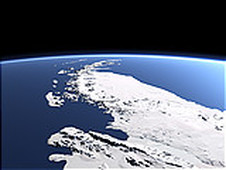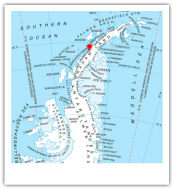
Ellsworth is a city on the west coast peninsula of Antarctica, seen in the picture to the left, where our story takes place, the most amazing place on the planet in my opinion. But perhaps I'm somewhat bias, you see, I've always had a fascination with Antarctica. There was 1982 and I was just twelve years old when I first saw John Carpenter's, "The Thing." As brilliant as it was horrifying, I found the environment sounding them far more intriguing. Where was this mysterious place, this alien world of ice right here on our very own planet? The enigmatic scenery made the whole story far more interesting, but even more so frightening. Written in 1938 by author John Campbell, a trans-morphing alien creature that has been frozen in the ice for over 100,000 years has been removed by a team of Norwegian scientists. But after bringing it back to their base, where it thaws from its frozen slumber, they become prey to a hideous monster. A predatory micro organism that consumes its victims replicating their physical appearance. One by one, the team is devoured as the creature hides among them, causing suspicion, fear and distrust among the surviving members. Perhaps John Carpenter took only some liberty with the plot line while keeping it true to the original story. John Campbell, in my opinion was light years ahead of his time for the sci-fi and horror genre of that time period. And by placing the stories location in the middle of a frozen continent isolated from the rest of civilization was the absolute pinnacle to this alien gore-fest. Where could one go from there? Who could you call for help where no one can here you scream? If the grotesque monsters didn't kill you, the environment surely would. This grew on me for many years. I began studying maps and reading books about Antarctica and its explorations over the past century. I was absolutely fascinated with this strange and wondrous world at the bottom of our planet, surrounded by a prolifically developed civilization. This enormous frozen continent looked so out of place, leaving me with so many questions, like. What is down there beneath all that ice? And who really goes there? Honestly, there was not much written about it back then other than a few bad horror novels and a handful of nonfiction science textbooks, which left me to utilize my own imagination. It wasn't until I discovered Ernest Shackleton's biographical journal simply titled "South" a gripping adventure of the first attempted transcontinental expedition, which began in total disaster, only to go "South" quickly from there, (excuses the pun) chronicling their heroic yearlong strife for survival on the ice in the harshest climate on earth up until they are rescued. Photographer, Frank Hurley documented the expedition from beginning to end through a remarkable collection of high quality films and photographs. Their voyage was of epic proportion and I doubt that any of the best movies made so far, or to be, can possibly replicate the perpetual hell that he and his crew had to endure.
It would take us about another 70 years or so before we began to understand the significance of our Polar Regions relationship with our planet's environmental matrix, or the chaos that will result from carelessly contributing to its demise. Clean water is without doubt the most precious element on our planet, the most essential key to our survival. Nothing is worth destroying our environment for, no precious metal or gem can come close to the value of clean water or a life supporting atmosphere. That’s simply a no-brainer! The fact is, the past century of frenzied industrial pollution in addition to continuous warfare and nuclear experiments around the entire planet has forced trillions of tons of carbon chemicals into our atmosphere causing cataclysmic changes to our environment at an accelerated rate unlike any other in our planet's history since the late Jurassic period. Of course, there are many who feel this is a reasonable trade for temporary wealth. And those who do prosper from the suffering of all life on earth are the venerable ones who control our economy, leaving the masses in silence beneath their illustrious shadows. But don't worry; at least their descendants may have the chance to enjoy our future. It’s funny how we spend so much time and money looking for other habitable planets when we can't even take care of the one we have. But the worst factor in this century long Slag revolution has been the undeniable damage to ourselves, the illnesses that have been carelessly inflicted on the innocent denizens of our planet has cost us ten fold more in health care costs than it has in total corporate profits. Hence the demise of institutionalized health care. Way to go! Not such a big investment when you reflect on it. And now that the majority of nations on our planet are fully engaged in another world war, mostly over land and resources, as usual. I wouldn't be surprised if our situation became far worse before showing any signs of improvement.
It would take us about another 70 years or so before we began to understand the significance of our Polar Regions relationship with our planet's environmental matrix, or the chaos that will result from carelessly contributing to its demise. Clean water is without doubt the most precious element on our planet, the most essential key to our survival. Nothing is worth destroying our environment for, no precious metal or gem can come close to the value of clean water or a life supporting atmosphere. That’s simply a no-brainer! The fact is, the past century of frenzied industrial pollution in addition to continuous warfare and nuclear experiments around the entire planet has forced trillions of tons of carbon chemicals into our atmosphere causing cataclysmic changes to our environment at an accelerated rate unlike any other in our planet's history since the late Jurassic period. Of course, there are many who feel this is a reasonable trade for temporary wealth. And those who do prosper from the suffering of all life on earth are the venerable ones who control our economy, leaving the masses in silence beneath their illustrious shadows. But don't worry; at least their descendants may have the chance to enjoy our future. It’s funny how we spend so much time and money looking for other habitable planets when we can't even take care of the one we have. But the worst factor in this century long Slag revolution has been the undeniable damage to ourselves, the illnesses that have been carelessly inflicted on the innocent denizens of our planet has cost us ten fold more in health care costs than it has in total corporate profits. Hence the demise of institutionalized health care. Way to go! Not such a big investment when you reflect on it. And now that the majority of nations on our planet are fully engaged in another world war, mostly over land and resources, as usual. I wouldn't be surprised if our situation became far worse before showing any signs of improvement.

This was my prediction of our future, and why so many years ago I began to envision a new kind of world, a bit impractical in some aspects but still quite possible. Not so much of your typical post apocalyptic wasteland envisioned in many 1980's era novella, but a more peaceful world created by intelligent methodical minded scholars rather than industrial minded politicians and corporations. A society which lives symbiotically with its surroundings much the way nature has intended us to do. Only in such a manner could we evolve beyond the persistent dogma of old-world imperialistic hierarchy and into a long sought Utopian model. Only this takes place on a whole new continent, Antarctica. After another century of war and accelerated climate change, the continent of Antarctica has begun to melt off at an exceeding rate, exposing much of its primitive virgin land beneath the ancient ice. Run off of polar ice melt has raised sea levels, pushing the coastlines further inland while concentrating the exceedingly overpopulated masses. Thus causing widespread conflict, anarchy, famine and disease in conjunction with elevated temperatures. People are dying by the thousands every day, which brings the worlds focus on the much cooler and cleaner environment with a vast wealth of life sustaining resources... Antarctica. The International Coalition of Science, or ICS, commonly referred to as ICE, has constructed a great city around an abandoned open-mining pit several miles wide and deep on the western coast of the Antarctic Peninsula, which hosts a more hospitable location of the continent. The city is named “Ellsworth”, after the famous polar navigator, Lincoln Ellsworth, who is also honored for the Ellsworth Mountains. “This is my best short synopsis by the way...stick with me,” Thus making it the most sought after location for people to live. But as usual in our modern society, the world’s foremost elitists will have top priority. The only problem with this new exodus is that Antarctica is protected by the oldest and most paramount treaty ever signed by the largest number of nations in world history, consenting international governance. No one single nation owns or claims sovereignty, nor will any consultative member allow another to hold such claim. So, what was once the longest and most peaceful treaty in human existence will now become the focus of discord in a time that has become increasingly desperate. ICS struggles to preserve the treaty while keeping the pristine land and water out of the hands of a corrupt Global Union. But the GRANT Corporation, Global Resources and Natural Trades, has consumed the world's economy through exponential dominance and has great influence over the Union and its leaders of State. And not for the humanitarian reasons which they've promised, only to persuaded their consortium of bidders, but rather to continue their search for an elusive isotope and a long lost legendary technology that will grant them absolute dominance of the world.
Our haphazard hero is an innocent young physicist named Bane Elrick, who through mere association is drawn into conflict between ICS and Grant Corp. and their long historical contest to control the entire continent along with all it has to offer. Well he’s not the only hero of this story; he’s more like the brains behind our real hero’s. At a young age, our heroic prodigy, Bane, losses his mother, Alison Elrick, a freelance geologist to a freak accident while studying a deep crevice in the ice shelf. He is left with many fond memories, words of sound advice and a few bizarre clues of what lead to her fate. Bane is raised by his father Marlin Elrick, a prestigious Architect and newly appointed city manager, who through his depression over the loss of his wife tries very hard to keep a close and often neurotic watch over his only son, Bane. But as the ensuing conflict between ICS and Grant draws closer to home, Bane is offered the opportunity of a lifetime to work for ICS president, Pierce Gödel, whose family fortune was made by a secret method of engineering living body parts. Dr. Gödel himself is a victim of post rivalry with Grant, surviving an incident that claimed the lives of his young daughter and beautiful wife with their unborn child, leaving his paralyzed body encased within a self-made endodermic suit, which keeps him only alive and able enough to peruse his retribution.
The concept of my Endodermic-Suit was based solely on my own true-life practices with actual functioning medical appliances while working in the rehabilitation field for the past 20 years. Same with all other medical concepts described within this book.
